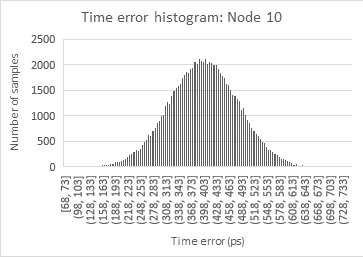
# News
John Fischer Receives ION’s 2022 Distinguished PTTI Service Award

These results show a time accuracy below 500 ps for the tenth node of the daisy chain. The jitter increases with each hop, as well as peak-to-peak time error, but its jitter is still lower than 100 ps for the last node of the chain, so the stability of the signal is well preserved along the path.
In terms of the low jitter frequency distribution capability, the following figure shows the phase noise comparison for all the nodes of the daisy chain.
As it can be seen, all the nodes of the system present a phase noise better than -90 dBc/Hz at 10 Hz.
The degradation in the jitter introduced by each hop of the daisy chain is also visible, being with the grandmaster (GM) the device which provides showing the best performance (RMS jitter of 1.1 ps integrated from 1Hz up to 100kHz) and increasing jitter until the last node the one which provide the worst (3.8ps).

Conclusions
C5ISR systems are intrinsically distributed and, by their own nature of systems of systems, can be analyzed as a sensor network. One of the most important sensors on the network is the radar, and its very demanding time and frequency synchronization requirements make the new IEEE-1588-2019 High Accuracy standard based on the White Rabbit protocol ideal.
This protocol will allow digitally programmable frequency with low phase noise at the up and down converters present in the transmitter and the receiver as well as time with very low jitter to the signal processing blocks, triggers, time stampers, and phased array antennas.
Finally, Orolia has increased the benefits of its equipment with features including cybersecurity mechanisms, resilience (failover algorithm, holdover, etc.), and monitoring, which will allow the user to always have a robust system under their complete control.


